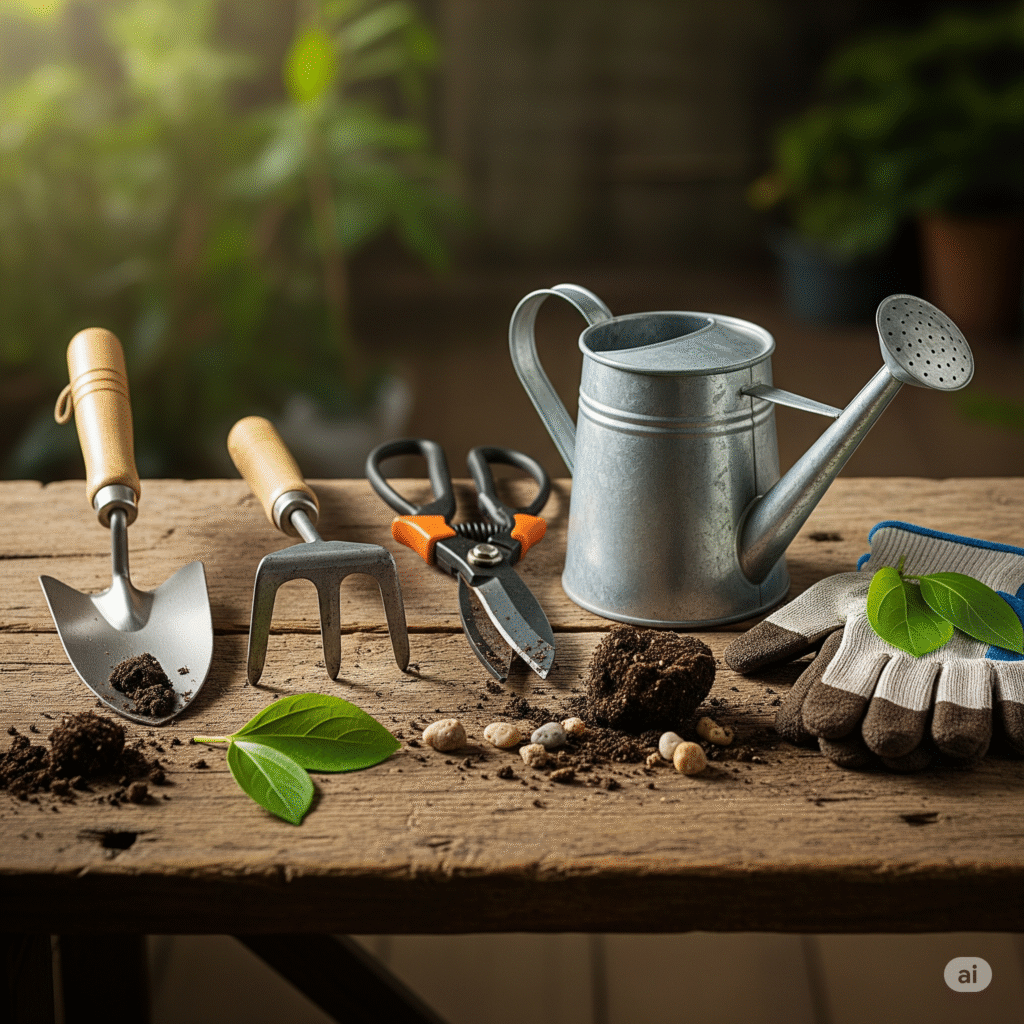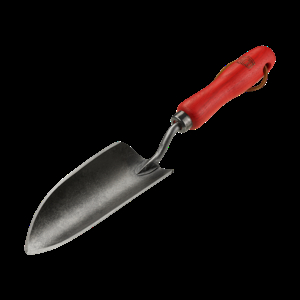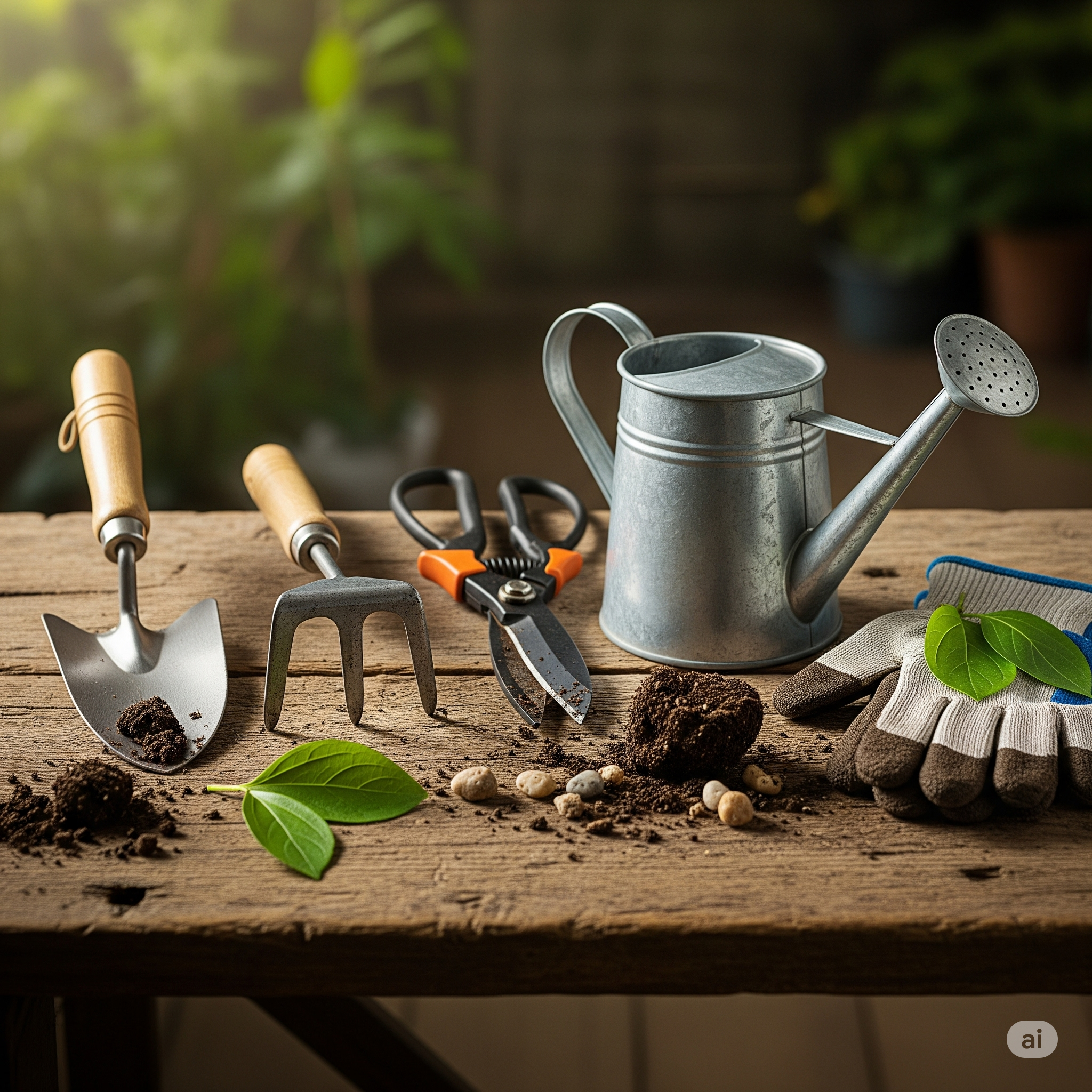
Ever dreamed of stepping out your back door and plucking fresh, vibrant vegetables or fragrant herbs right from your own garden? Maybe you picture colorful blooms adding joy to your space. It’s a wonderful dream, right? But then, the reality kicks in: you look online, or stroll through a garden center, and suddenly you’re staring at shelves packed with hundreds of different tools. Spades, forks, tillers, dibblers, cultivators, hoes, edgers… the list goes on! It’s enough to make anyone’s head spin, and frankly, enough to make you think starting a garden requires a serious financial investment.
Sound familiar? You’re not alone. Many aspiring green thumbs get overwhelmed by the sheer volume of “must-have” gadgets out there. The truth? A lot of it is just marketing. You absolutely do not need a shed full of expensive equipment to get started. In fact, you can kickstart your gardening journey with just a handful of affordable, versatile tools. Yes, really!
This post is here to cut through the clutter and tell you exactly what you need – and what you don’t. We’re talking about five essential, budget-friendly tools that will empower you to dig, plant, prune, and nurture your way to a thriving garden, without breaking the bank. Ready to save some serious cash and get your hands dirty? Let’s dig in!
Why You Don’t Need to Break the Bank to Grow Green
Before we dive into our fantastic five, let’s tackle a common misconception: that gardening is an expensive hobby. While it certainly can be if you go all-out on fancy raised beds, automated irrigation systems, and every single shiny tool known to humanity, it doesn’t have to be. Think of it like cooking: you can spend thousands on a professional kitchen, or you can whip up delicious meals with a few good pots, pans, and knives. Gardening is no different.
Starting small and simple has huge advantages, especially for beginners:
- Less Intimidation: Fewer tools mean less to learn and less to store.
- Lower Upfront Cost: Keep your wallet happy! This means you can invest more in quality soil or seeds.
- Versatility is Key: The tools we’ll discuss are multi-functional, doing the job of several specialized gadgets.
- Focus on Learning: When you’re not worried about managing a tool arsenal, you can focus on the real magic: understanding your plants, soil, and local climate.
- Sustainable Practice: Buying fewer, quality tools reduces waste and encourages thoughtful consumption.
So, forget the idea that you need to mortgage your house for a beautiful garden. All you need is enthusiasm, a little bit of knowledge, and these five humble heroes.
The Essential Five: Your Gardening Dream Team
Alright, drumroll please! Here are the only five tools you truly need to embark on your gardening adventure. Each one serves multiple purposes, making them incredibly valuable for their low cost.
1. A Sturdy Hand Trowel: Your Go-To Digger

If there’s one tool that truly embodies the spirit of gardening, it’s the hand trowel. This isn’t just a simple digging tool; it’s your garden’s most versatile companion. Think of it as the ultimate multi-tool for your hands.
What it is: A small, scoop-shaped spade with a handle, designed to be held in one hand.
Why it’s essential: The hand trowel is your primary instrument for almost every planting task. It allows for precision digging in tight spaces, making it perfect for container gardening, raised beds, or established garden plots. Its small size makes it less cumbersome than a full-sized shovel, which can be overkill for most home garden tasks.
How to use it (and why it’s so versatile):
- Planting seedlings: This is its main job. Dig a small hole just the right size for your plant’s root ball.
- Transplanting: Gently scoop up established plants you want to move, taking care to preserve the root system.
- Weeding: Its sharp edge and pointed tip are fantastic for prying out stubborn weeds, especially those with taproots. You can get right under them and pop them out without disturbing nearby plants too much.
- Mixing soil: Need to add some compost or fertilizer to a small area? Use your trowel to gently mix it into the topsoil.
- Filling containers: Scoop potting mix into your pots and planters with ease.
- Creating small furrows: For planting rows of seeds, you can drag the tip to make a neat little groove.
Buying Tip: Look for a trowel with a strong metal blade (stainless steel or forged steel is great) that extends into the handle. This prevents the head from bending or breaking off. A comfortable grip is also crucial, especially if you plan on extended gardening sessions.
2. Hand Cultivator/Fork: The Soil Fluffer & Weed Extractor

While the trowel digs, the hand cultivator (sometimes called a hand fork) aerates and loosens. Imagine your garden soil as a fluffy cake – a cultivator helps keep it that way, which is vital for roots to breathe and water to penetrate. It’s truly a game-changer for soil health and tackling those annoying weeds.
What it is: A hand-held tool with three or four short, sharp prongs, resembling a miniature pitchfork.
Why it’s essential: Healthy soil is the foundation of a healthy garden. A hand cultivator helps you maintain that healthy soil structure without resorting to heavy, expensive rototillers. It’s also remarkably effective at dislodging shallow-rooted weeds.
How to use it (and why it’s so versatile):
- Loosening compacted soil: If your soil feels hard or crusty, gently work the prongs into it to break it up. This improves drainage and allows air and water to reach plant roots.
- Weeding: The prongs are excellent for raking out small weeds just starting to emerge. For larger weeds, you can use the prongs to loosen the soil around the roots before pulling them out by hand or with your trowel.
- Mixing amendments: When adding compost, fertilizer, or soil amendments, use the cultivator to blend them evenly into the top few inches of soil.
- Preparing seedbeds: After digging a bed with your trowel, use the cultivator to refine the soil, making it fine and crumbly for tiny seeds.
- Aerating containers: Potted plants can get compacted soil over time. Gently poke and twist the cultivator in the pot to aerate without disturbing roots too much.
Buying Tip: Look for sturdy, rigid prongs that won’t bend easily. Stainless steel is a good choice for rust resistance. A comfortable, ergonomic handle will reduce hand fatigue.
3. Pruning Shears (Hand Pruners/Snips): For Tidiness and Health

Once your plants start growing, you’ll inevitably need to do some trimming. Whether it’s harvesting herbs, snipping off spent flowers (deadheading), or removing a diseased branch, a good pair of pruning shears is indispensable. They make clean cuts, which is vital for plant health, unlike tearing or crushing with scissors.
What it is: Hand-held, scissor-like tools with strong, sharp blades designed for cutting branches, stems, and flowers.
Why it’s essential: Pruning shears allow for precise cuts, which is crucial for the health of your plants. Clean cuts heal faster, reducing the risk of disease. They are far more effective and safer for plants than using kitchen scissors or simply tearing. You’ll use them for harvesting, shaping, and basic plant maintenance.
How to use it (and why it’s so versatile):
- Harvesting vegetables and herbs: Cleanly snip off lettuce leaves, basil sprigs, or ripe tomatoes without damaging the rest of the plant.
- Deadheading flowers: Remove faded flowers to encourage the plant to produce more blooms and prevent it from putting energy into seed production.
- Shaping plants: Keep your plants looking tidy and encourage bushier growth by selectively trimming stems.
- Removing diseased or dead parts: Quickly snip away any unhealthy leaves or stems to prevent disease spread and encourage new growth.
- Cutting small branches: Ideal for small woody stems up to about half an inch in diameter.
Buying Tip: There are two main types: bypass (like scissors, best for live green wood) and anvil (a blade cutting onto a flat surface, good for dead wood). For general home gardening, a bypass pruner is usually the better choice for its clean cuts. Look for sharp, rust-resistant blades and a comfortable, spring-loaded handle for ease of use. Keep them clean and sharp for best results.
4. Gardening Gloves: Your Hands’ Best Friend

This isn’t a digging tool, but it’s arguably just as important for a comfortable and enjoyable gardening experience. Your hands are your primary tools in the garden, and protecting them from thorns, splinters, dirt, and blisters is paramount. Trust me, a good pair of gloves makes all the difference.
What it is: Durable gloves designed specifically for gardening tasks.
Why it’s essential:
- Protection from thorns and sharp objects: No more painful encounters with rose thorns or hidden bits of glass.
- Preventing blisters and calluses: Extended digging and weeding can be rough on bare hands.
- Keeping hands clean: While getting dirty is part of the fun, having mud caked under your fingernails for days isn’t.
- Avoiding skin irritations: Some plants or soil components can irritate sensitive skin.
- Better grip: Many gardening gloves offer enhanced grip, especially when dealing with wet soil or slippery tools.
How to use it: Simply wear them! But choose wisely. Not all gloves are created equal. You want a pair that offers protection without sacrificing dexterity. You should still be able to feel what you’re doing, but with a layer of defense.
Buying Tip: Look for gloves that fit snugly but aren’t too tight. A combination of breathable fabric on the back and a durable, water-resistant material like leather or synthetic leather on the palm and fingers is ideal. Nitrile-dipped gloves are excellent for wet tasks and maintaining dexterity.
5. Watering Can (or a Simple Hose with Nozzle): The Lifeblood Supplier

Last but certainly not least, your garden won’t thrive without water. While a hose might seem obvious, a dedicated watering can offers precision and gentleness that a strong hose spray often can’t, especially for young seedlings or container plants. It’s simple, effective, and gives you total control.
What it is: A container with a handle and a spout, often with a “rose” (a sprinkler head) for gentle watering.
Why it’s essential: Consistent and appropriate watering is critical for plant survival and growth. A watering can allows you to deliver water directly to the plant’s roots, minimizing waste and preventing splashing soil onto leaves (which can spread disease). The “rose” attachment ensures a soft, rain-like spray that won’t flatten delicate seedlings or wash away soil.
How to use it:
- Targeted watering: Direct water exactly where it’s needed – at the base of the plant.
- Gentle for seedlings: The fine spray from the rose attachment is perfect for young, fragile plants that could be damaged by a strong stream of water.
- Container plants: Ideal for precise watering of potted plants, ensuring even moisture without overflow.
- Applying liquid fertilizer: Many liquid feeds require dilution; a watering can makes it easy to mix and apply evenly.
- Control: You have complete control over the amount and intensity of water, preventing overwatering or underwatering.
Buying Tip: Choose a size that’s comfortable for you to lift when full. Plastic watering cans are lightweight and durable, while galvanized steel or copper can be more aesthetic and long-lasting. Ensure the handle is ergonomic and the spout provides a smooth, controlled flow. If you have a larger garden, a hose with an adjustable nozzle is a great alternative or addition, allowing you to switch from a gentle shower to a stronger stream for different needs.
Beyond the Tools: Simple Secrets for Beginner Success
While having the right (and few!) tools is a fantastic start, remember that gardening is also about understanding a few basic principles. These aren’t extra costs, just smart choices that will make your efforts much more rewarding:
- Sunlight is King: Most vegetables and flowers need at least 6-8 hours of direct sunlight per day. Observe your space before you plant!
- Soil is the Foundation: You don’t need fancy bags of “potting mix” for every bed. Good soil is rich in organic matter. You can improve existing soil by adding compost, which you can often get cheaply or even make yourself!
- Water Wisely: It’s better to water deeply and less frequently than to sprinkle a little every day. Deep watering encourages roots to grow down, making plants more resilient. Stick your finger an inch or two into the soil; if it feels dry, it’s time to water.
- Start Small, Learn Big: Don’t try to grow everything at once. Pick a few easy-to-grow plants that you’ll actually eat or enjoy. Think radishes, lettuce, basil, cherry tomatoes, or marigolds. Success with a small garden builds confidence for bigger projects.
- Observe and Learn: Your garden will teach you the most. Pay attention to how your plants respond to water, sun, and care. Notice pests early. Every “mistake” is a learning opportunity!
Saving Money Isn’t Just About Tools: Smart Choices for Your Garden
Our focus has been on tools, but the “affordable” aspect of gardening extends to other areas too. Here are a few more tips to keep your budget happy:
- Buy Seeds, Not Plants: While starter plants are convenient, seeds are exponentially cheaper. A packet of seeds costs a few dollars and can yield dozens of plants, compared to a single plant for the same price.
- Embrace Composting: Turn your kitchen scraps and yard waste into “black gold” – nutrient-rich compost that will feed your plants for free. It’s the ultimate recycling program for gardeners.
- Recycle and Repurpose: Old plastic containers, milk jugs, or even sturdy grocery bags can be used for starting seeds or temporary planters. Don’t feel pressured to buy expensive designer pots.
- Swap with Friends: Have too many zucchini? Your neighbor has a bounty of tomatoes? Start a garden swap! You can also exchange seeds or plant cuttings with fellow gardeners.
- Learn About Native Plants: Native plants are often adapted to your local climate and soil, meaning they require less water and maintenance once established.
Ready to Dig In? Your Journey Starts Now!
See? Starting a garden doesn’t have to be complicated or expensive. With just five affordable, multi-functional tools – your hand trowel, hand cultivator/fork, pruning shears, gardening gloves, and a reliable watering can – you’re more than equipped to begin your green adventure.
What are you waiting for? Forget the gadget gurus and the overwhelming options. Grab these five humble heroes, pick out a few packets of seeds, find a sunny spot, and get ready to experience the incredible joy and satisfaction of growing your own. There’s something truly magical about watching life emerge from the soil, nurtured by your own hands. Your affordable, thriving garden awaits!
If you need to know more about the soil secrets check our more blogs click here.

